Related Research Articles

Perfume is a mixture of fragrant essential oils or aroma compounds (fragrances), fixatives and solvents, usually in liquid form, used to give the human body, animals, food, objects, and living-spaces an agreeable scent. The 1939 Nobel Laureate for Chemistry, Leopold Ružička stated in 1945 that "right from the earliest days of scientific chemistry up to the present time, perfumes have substantially contributed to the development of organic chemistry as regards methods, systematic classification, and theory."

Electron ionization is an ionization method in which energetic electrons interact with solid or gas phase atoms or molecules to produce ions. EI was one of the first ionization techniques developed for mass spectrometry. However, this method is still a popular ionization technique. This technique is considered a hard ionization method, since it uses highly energetic electrons to produce ions. This leads to extensive fragmentation, which can be helpful for structure determination of unknown compounds. EI is the most useful for organic compounds which have a molecular weight below 600. Also, several other thermally stable and volatile compounds in solid, liquid and gas states can be detected with the use of this technique when coupled with various separation methods.
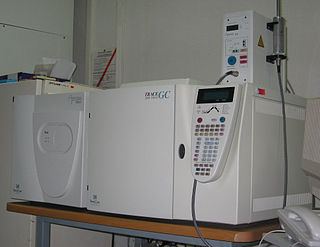
Gas chromatography–mass spectrometry (GC-MS) is an analytical method that combines the features of gas-chromatography and mass spectrometry to identify different substances within a test sample. Applications of GC-MS include drug detection, fire investigation, environmental analysis, explosives investigation, and identification of unknown samples, including that of material samples obtained from planet Mars during probe missions as early as the 1970s. GC-MS can also be used in airport security to detect substances in luggage or on human beings. Additionally, it can identify trace elements in materials that were previously thought to have disintegrated beyond identification. Like liquid chromatography–mass spectrometry, it allows analysis and detection even of tiny amounts of a substance.

An aroma compound, also known as an odorant, aroma, fragrance or flavor, is a chemical compound that has a smell or odor. For an individual chemical or class of chemical compounds to impart a smell or fragrance, it must be sufficiently volatile for transmission via the air to the olfactory system in the upper part of the nose. As examples, various fragrant fruits have diverse aroma compounds, particularly strawberries which are commercially cultivated to have appealing aromas, and contain several hundred aroma compounds.
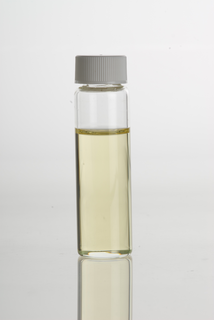
Rose oil is the essential oil extracted from the petals of various types of rose. Rose ottos are extracted through steam distillation, while rose absolutes are obtained through solvent extraction, the absolute being used more commonly in perfumery. The production technique originated in Persia. Even with their high price and the advent of organic synthesis, rose oils are still perhaps the most widely used essential oil in perfumery.

International Flavors & Fragrances is an American corporation that produces flavors, fragrances, and cosmetic actives, which it markets globally. It is headquartered in New York City and has creative, sales, and manufacturing facilities in 47 different countries. The company is a member of the S&P 500 Index.

Gomphrena globosa, commonly known as globe amaranth, is an edible plant from the family Amaranthaceae. The round-shaped flower inflorescences are a visually dominant feature and cultivars have been propagated to exhibit shades of magenta, purple, red, orange, white, pink, and lilac. Within the flowerheads, the true flowers are small and inconspicuous.

Two-dimensional chromatography is a type of chromatographic technique in which the injected sample is separated by passing through two different separation stages. Two different chromatographic columns are connected in sequence, and the effluent from the first system is transferred onto the second column. Typically the second column has a different separation mechanism, so that bands that are poorly resolved from the first column may be completely separated in the second column. Alternately, the two columns might run at different temperatures. During the second stage of separation the rate at which the separation occurs must be faster than the first stage, since there is still only a single detector. The plane surface is amenable to sequential development in two directions using two different solvents.
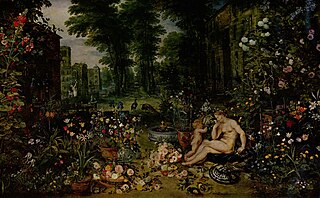
An odor or odour is caused by one or more volatilized chemical compounds that are generally found in low concentrations that humans and animals can perceive by their sense of smell. An odor is also called a "smell" or a "scent", which can refer to either a pleasant or an unpleasant odor.
Synthetic musks are a class of synthetic aroma compounds to emulate the scent of deer musk and other animal musks. Synthetic musks have a clean, smooth and sweet scent lacking the fecal notes of animal musks. They are used as flavorings and fixatives in cosmetics, detergents, perfumes and foods, supplying the base note of many perfume formulas. Most musk fragrance used in perfumery today is synthetic.

Roman Kaiser is a Swiss fragrance chemist. Since 1968 he has been working at Givaudan, the world's largest company in the flavour and fragrance industry, where he analyzes and reconstitutes natural scents for use in perfumery using the headspace technology which he pioneered and which as a new concept made significant impact on the analysis of natural products.
A captive odorant, or short captive, is an odorant or aroma chemical retained by the originating manufacturer for exclusive use in their own perfumes to protect them from imitation.

Lilial is a chemical compound commonly used as a perfume in cosmetic preparations and laundry powders, often under the name butylphenyl methylpropional. It is a synthetic aromatic aldehyde. It was banned for use in cosmetics by the EU in March 2022 after being found to be harmful to fertility.
Christophe Laudamiel is a French perfumer. He is founder and master perfumer of DreamAir creative studios in New York City, where he currently resides. In 2019 he was named chief perfumer to BélAir Lab in Tokyo: a perfume composition and technology studio newly managed by Roto Pharmaceuticals. He is a founder and president of the non-profit Academy of Perfumery and Aromatics.
Analytical thermal desorption, known within the analytical chemistry community simply as "thermal desorption" (TD), is a technique that concentrates volatile organic compounds (VOCs) in gas streams prior to injection into a gas chromatograph (GC). It can be used to lower the detection limits of GC methods, and can improve chromatographic performance by reducing peak widths.
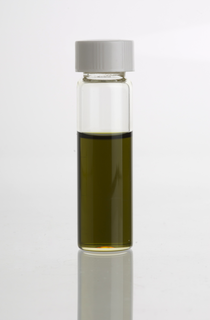
Bergamot essential oil is a cold-pressed essential oil produced by cells inside the rind of a bergamot orange fruit. It is a common flavoring and top note in perfumes. The scent of bergamot essential oil is similar to a sweet light orange peel oil with a floral note.
Scentography is the technique of creating and storing odor by artificially recreating a smell using chemical and electronic means.
Headspace gas chromatography uses headspace gas—from the top or "head" of a sealed container containing a liquid or solid brought to equilibrium—injected directly onto a gas chromatographic column for separation and analysis. In this process, only the most volatile substances make it to the column. The technique is commonly applied to the analysis of polymers, food and beverages, blood alcohol levels, environmental variables, cosmetics, and pharmaceutical ingredients.
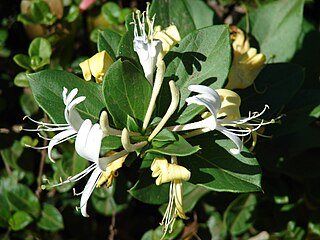
Floral scent or flower scent is composed of all the volatile organic compounds (VOCs), or aroma compounds, emitted by floral tissue. Floral scent is also referred to as aroma, fragrance, floral odour or perfume. Flower scent of most flowering plant species encompass a diversity of VOCs, sometimes up to several hundred different compounds. The primary functions of floral scent are to deter herbivorous and especially florivorous insects, and to attract pollinators. Floral scent is one of the most important communication channels mediating plant-pollinator interactions, along with visual cues.
Sillage in perfume refers to the trail created by a perfume when it is worn on the skin. It comes from the word in French for "wake" and can best be described as how a fragrance diffuses behind the wearer as they move. A fragrance does not need to be a heavy one to have a large sillage.
References
- ↑ Omar, Jone; Olivares, Maitane; Alonso, Ibone; Vallejo, Asier; Aizpurua-Olaizola, Oier; Etxebarria, Nestor (2016-04-01). "Quantitative Analysis of Bioactive Compounds from Aromatic Plants by Means of Dynamic Headspace Extraction and Multiple Headspace Extraction-Gas Chromatography-Mass Spectrometry". Journal of Food Science. 81 (4): C867–C873. doi:10.1111/1750-3841.13257. ISSN 1750-3841. PMID 26925555.
- ↑ Kaiser, Roman (1997), "Environmental Scents at the Ligurian Coast", Perfumer & Flavorist, 22: 7–18
- ↑ Knudsen, Jette T.; Tollsten, Lars; Bergström, L.Gunnar (1993), "Floral scents—a checklist of volatile compounds isolated by head-space techniques", Phytochemistry, 33 (2): 253–280, doi:10.1016/0031-9422(93)85502-i
- ↑ Mookherjee, B.D.; Trenkle, R.W.; Wilson, R.A.; Zampino, M.; Sands, K.P.; Mussinan, C.J. (1988). “Fruits and flowers: live vs dead--which do we want?”. Flavors and Fragrances: A World Perspective. Elsevier Science Pub. pp. 415–424. ISBN 0-444-42964-6.
- ↑ Mookherjee, Braja D.; Trenkle, Robert W.; Wilson, Richard A. (1989). "Live vs. Dead. Part II. A Comparative Analysis of the Headspace Volatiles of Some Important Fragrance and Flavor Raw Materials". Journal of Essential Oil Research. 1:2: 85-90. doi:10.1080/10412905.1989.9697755.
- ↑ Charles (Ed.), Sell; Karen Jenner (2005). "Chapter 14. The Search for Fragrance Ingredients". The Chemistry of Fragrances (2nd ed.). Royal Society of Chemistry Publishing. pp. 254–293. ISBN 978-0-85404-824-3.CS1 maint: extra text: authors list (link)
- ↑ Charles (Ed.), Sell; Robin Clery (2005). "Chapter 12. Natural Product Analysis in the Fragrance Industry". The Chemistry of Fragrances (2nd ed.). Royal Society of Chemistry Publishing. pp. 214–228. ISBN 978-0-85404-824-3.CS1 maint: extra text: authors list (link)